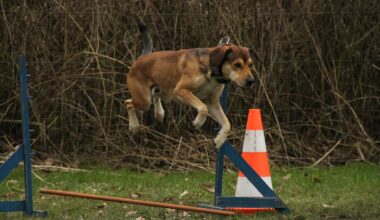The Intersection of Animal Control and Zoning Regulations
The regulation of dogs within urban areas intersects significantly with zoning laws, creating a complex legal landscape that both dog owners and municipalities must navigate. Zoning laws are established to organize land use, but they also indirectly regulate how many and what type of pets individuals can own in specific districts. For instance, a residential zone might limit the number of dogs per household, impacting families who wish to adopt multiple pets. Such regulations are often put in place to reduce nuisance complaints related to barking or messes that dogs can create. Moreover, zoning laws differ widely from one locality to another, complicating compliance for dog owners who may move from area to area. It is crucial for pet owners to understand their local zoning laws to avoid potential fines or penalties. Engaging with local authorities or pet advocacy groups can provide valuable insights. Many owners strive to balance their dog ownership desires with compliance to avoid legal pitfalls. Knowing the rules not only helps prevent issues but also fosters better relationships with the community.
In addition to zoning laws, understanding animal control ordinances is vital for dog owners. These ordinances define the responsibilities of pet owners regarding leash laws, licensing, and behaviors considered nuisances. Animal control statutes ensure public safety as well, often mandating vaccinations and regular health checks for dogs. Zoning regulations sometimes complement these animal control laws, resulting in a dual layer of governance for dog ownership. For instance, a specific neighborhood may have additional regulations pertaining to types of breeds permitted based on local perceptions of danger or aggression. Consequently, dog owners should remain informed and updated regarding the intersections of these regulations. Local government websites and public forums serve as excellent resources for understanding these statutes. Pet owners can also seek legal advice if they suspect that certain zoning laws might be unfair or overly restrictive. Participation in community discussions concerning these regulations permits owners to advocate for change and better conditions for dogs. Being proactive can influence future zoning laws, making it easier for responsible dog owners to coexist within urban settings.
Community Impacts on Zoning and Animal Control
The implications of zoning laws for dogs extend beyond pet ownership, impacting community values and cohesion. Areas with strict zoning may inadvertently foster a culture of exclusion for pet lovers, deterring dog-related businesses like parks or grooming facilities. Such restrictions can adversely affect a community’s character, particularly in neighborhoods that see significant pet ownership. To foster dog-friendly environments, residents often band together to propose amendments to existing zoning regulations. Engaging in pet advocacy groups can amplify these efforts, providing a stronger voice for responsible dog ownership and inclusive community standards. Conversely, misunderstandings regarding zoning regulations may lead to community tension, where dog owners and non-pet owners clash over noise or cleanliness. Educating both sides about the intended purposes of zoning and animal control laws can mitigate such conflicts, promoting positive communication and understanding. Many communities offer resources for educating residents about responsible pet ownership. Ultimately, fostering respect among residents is crucial in balancing the interests of dog owners with community standards. Bridging gaps in understanding can pave the way for mutual cooperation and community harmony.
Pet forums and social media groups are also valuable tools for dog owners seeking to navigate the complexities of zoning laws and animal control ordinances. Online platforms allow for sharing experiences, challenges, and strategies to overcome legal hurdles. Incoming pet owners can glean insights from veteran dog owners in their area about which regulations are more heavily enforced or often overlooked. By participating in these discussions, owners learn the art of compliance while still enjoying their pets. Additionally, these platforms can be mobilized to rally support for changes in legislation as they allow for mass communication of concerns to local representatives. Collective advocacy can often yield more significant results than individual efforts alone, showcasing to local governments the importance of pet-friendly regulations that cater to responsible dog ownership. Furthermore, these communities foster connections among dog owners, promoting responsible practices not only in compliance but also in training and socialization for their pets. Social connections can lead to enhanced awareness about the broader impacts of dog ownership on neighborhoods and can pave the way for positive discussions surrounding zoning laws.
Challenges of Compliance and Legalities
The legal challenges associated with compliance to zoning laws and animal control ordinances can be daunting for many dog owners. Some might find the language of these laws intimidating, causing anxiety about inadvertently breaking them. Furthermore, the penalties for violations sometimes include hefty fines or even the forced removal of pets from their homes. Due to the varying nature of these laws from one municipality to another, legal inconsistencies often lead to confusion. Engaging a pet lawyer when faced with potential legal ramifications can alleviate these worries significantly. Legal counsel can clarify obligations under zoning and animal control laws, as well as represent a dog owner’s interests in disputes. This guidance not only aids in compliance but also empowers owners to challenge laws that seem unfair or misplaced. Additionally, understanding one’s rights regarding pet ownership can foster a sense of community empowerment. With informed voices, those advocating for changes in zoning regulations can command attention in local council meetings. This proactive approach encourages the adaptation of laws that acknowledge the value dogs bring to families and neighborhoods, ultimately benefiting everyone.
Ultimately, responsible dog ownership succeeds when pet owners actively participate in understanding and shaping zoning laws and animal control regulations. Zoning laws that accommodate dog ownership can enhance community engagement and contribute to a more vibrant atmosphere. Well-informed owners can aid in fostering environments where pets are viewed positively and inclusively rather than as troublesome nuisances. By participating in community dialogues and advocating for reasonable regulations, dog owners can influence the perception surrounding pets positively, promoting responsible pet ownership. Moreover, they can develop partnerships with local governments to create dog-friendly spaces. It’s essential for owners to learn and share knowledge about local laws while encouraging others to engage with their communities actively. By highlighting unique cultural aspects of dog ownership, communities can potentially shift toward more accommodating regulations. This engagement demonstrates how pets complement and enrich the quality of life. An inclusive approach bridges the gap between dog owners and non-owners, enhancing social interaction and fostering respect. As community members challenge outdated regulations, they pave the way for future generations to enjoy the benefits companionship dogs provide.
Conclusion: The Future of Zoning and Dogs
In conclusion, navigating the intersection of zoning laws and animal control is crucial for dog owners seeking to maintain a harmonious existence within their communities. As local governance continues to evolve, there is potential for regulations to adapt towards fostering more dog-friendly environments. However, the responsibility lies significantly with pet owners who must engage actively with their local governments and communities. By being informed and advocating for fair policies, dog owners can contribute positively. Working collectively, they can build strong communities that appreciate the presence of dogs. It’s essential to highlight the positive role dogs play in mental well-being and family dynamics because more communities can benefit from inclusive practices. Communities that embrace responsible pet ownership become vibrant ecosystems where dogs and people coexist harmoniously. Developing dog parks, organizing neighborhood clean-up events, and promoting responsible training programs can not only elevate the perception of dog ownership but also educate non-dog owners. The future of zoning and dog regulations depends on collaboration. By emphasizing the benefits of well-regulated dog ownership, communities will continue to thrive, highlighting the mutual respect between residents and pet lovers alike.
As the dialogue surrounding pet ownership continues to unfold, local governments will likely find themselves revisiting existing laws while considering proposals from stakeholders. Innovations in urban planning and community engagement strategies can pave the way for a transitional phase where zoning laws responsibly integrate dog ownership into their frameworks. By establishing partnerships between pet owners, local businesses, and community members, a culture of collaboration can emerge. This evolution signifies more than just relaxed regulations; it symbolizes society’s recognition of dogs as essential companions who profoundly impact human lives. The responsibility of adherence to these laws instills a sense of civic duty among pet owners while providing an opportunity for community enhancement through collaboration. Overall, zoning laws should promote responsible dog ownership, while individuals should embrace the opportunity to influence these regulations positively. By participating in local dialogues about animal control and zoning, owners can ensure that their voices are heard. Ultimately, as laws adapt to reflect societal changes in perception towards dog ownership, the future encapsulates hope for a more inclusive and understanding landscape.


